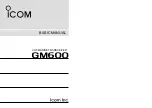
47
Advanced Function
—Continued
0 to 5
: Adjustable range.
When set to 5, nothing is subtracted from the left and
right channels. When set to 0, the left and right chan-
nel levels are halved (–6 dB), making the center
channel more dominant, particularly useful when the
listener is off-center.
This function has no effect on the level of the center
speaker.
Adjusting the PL II or PL IIx Music Mode
The following Panorama, Dimension, and Center Width
parameters can only be adjusted while the PL II Music or
PL IIx Music listening mode is selected.
These parameters cannot be adjusted if you’re using the
Pro Logic IIx listening mode for 6.1-channel playback
from a 5.1-channel source.
■
Panorama
With this function, you can extend the front stereo image
to the surround speakers to provide a “wraparound”
effect, especially useful when not much sound is being
output by the surround speakers.
■
Dimension
With this function, you can move the soundfield back-
ward or forward.
0 to 6:
Adjustable range.
When set to 3, the soundfield is in the normal posi-
tion. Choose a lower setting to move the soundfield
forward Choose a higher setting to move it back-
ward.
If the stereo image is too wide, or there’s too much sur-
round information, try moving the soundfield forward to
achieve a better balance. If the stereo image is too nar-
row, or it sounds almost like it’s in mono, try moving the
soundfield backward.
■
Center Width
With Pro Logic II/Pro Logic IIx decoding, the center-
channel signal is normally output by the center speaker.
If a center speaker is not used, the decoder divides the
center signal equally between the front left and right
speakers, producing what’s known as a “phantom” cen-
ter. With this function you can choose to have the center-
channel signal output by the center speaker only, by the
front left and right speakers only (“phantom” center), or
by a mix of the two.
0 to 7:
Adjustable range.
When set to 0, the center-channel signal is output by
the center speaker only. When set to 7, it’s output by
the front left and right speakers only (“phantom”
center).
In home theaters, adding some width to the center chan-
nel can improve the balance between the center and front
left and right speakers. Most stereo material will benefit
from appropriate use of this function.
The following table shows the display indicators for each
supported digital signal format.
Normally, the AV Receiver detects the signal format
automatically. However, if you experience either of the
following issues when playing PCM or DTS material,
you can set the signal format to PCM or DTS:
• If the beginnings of tracks from a PCM source are cut
off, try setting the format to PCM.
• If noise is produced when fast forwarding or reversing
a DTS CD or LD, try setting the format to DTS.
Digital Input Signal Formats
Format
Display
Dolby Digital
DTS
PCM
1
Press and hold the AV Receiver’s [DIGI-
TAL INPUT] button on the front panel for
about 3 seconds.
2
While “Auto” is displayed (about 3 sec-
onds), use the Left and Right [
]/[
] but-
tons to select: PCM, DTS, or Auto.
DTS or PCM;
the DTS or PCM indicator,
depending on which format you have set, flashes,
and only signals in that format are output. Digital
signals in other formats are ignored.
Auto (default);
the format is detected automati-
cally. If no digital input signal is present, the cor-
responding analog input is used instead.
STANDBY/ON
PHONES
STANDBY
DISPLAY
TONE
TUNING MODE
DIGITAL INPUT
LISTENING
MODE
STEREO
MEMORY
RETURN
SETUP
VIDEO
2
TAPE
TUNER
C D
VIDEO
3
DVD
VIDEO
1
VCR
MULTI CH
MASTER VOLUME
TUNING
ENTER
PRESET
S VIDEO
VIDEO
AUDIO
L
R
VIDEO
3 INPUT
CLEAR
SPEAKERS B
A
DIGITAL INPUT
TX-SR502̲En.book Page 47 Friday, March 12, 2004 1:05 PM














































